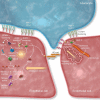The regulation of transendothelial migration: new knowledge and new questions
- PMID: 25987544
- PMCID: PMC4592322
- DOI: 10.1093/cvr/cvv145
The regulation of transendothelial migration: new knowledge and new questions
Abstract
Leucocyte transendothelial migration (TEM) involves a co-operative series of interactions between surface molecules on the leucocyte and cognate counter-ligands on the endothelial cell. These interactions set up a cascade of signalling events inside the endothelial cell that both allow for the junctions to loosen and for membrane to be recruited from the lateral border recycling compartment (LBRC). The LBRC is thought to provide an increased surface area and unligated receptors to the leucocyte to continue the process. The relative importance of the individual adhesion/signalling molecules that promote transmigration may vary depending on the type of leucocyte, the vascular bed, the inflammatory stimulus, and the stage of the inflammatory response. However, the molecular interactions between leucocyte and endothelial cell activate signalling pathways that disengage the adherens and tight junctions and recruit the LBRC to the site of transmigration. With the exception of disengaging the junctions, similar molecules and mechanisms promote transcellular migration as paracellular migration of leucocytes. This review will discuss the molecular interactions and signalling pathways that regulate transmigration, and the common themes that emerge from studying TEM of different leucocyte subsets under different inflammatory conditions. We will also raise some unanswered questions in need of future research.
Keywords: Adhesion molecules; Cell junctions; Diapedesis; Lateral border recycling compartment; Transendothelial migration.
Published on behalf of the European Society of Cardiology. All rights reserved. © The Author 2015. For permissions please email: journals.permissions@oup.com.
Figures



References
-
- Butcher EC. Leukocyte-endothelial cell recognition: three (or more) steps to specificity and diversity. Cell 1991;67:1033–1036. - PubMed
-
- Ley K, Laudanna C, Cybulsky MI, Nourshargh S. Getting to the site of inflammation: the leukocyte adhesion cascade updated. Nat Rev Immunol 2007;7:678–689. - PubMed
-
- Muller WA. PECAM: regulating the start of diapedesis . In: Ley K, ed. Progress in Inflammation Research. Basel, Switzerland: Birkhauser Verlag AG; 2007. p. 201–220.
Publication types
MeSH terms
Grants and funding
LinkOut - more resources
Full Text Sources
Other Literature Sources

